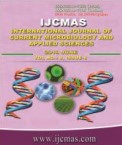


 National Academy of Agricultural Sciences (NAAS)
National Academy of Agricultural Sciences (NAAS)

|
PRINT ISSN : 2319-7692
Online ISSN : 2319-7706 Issues : 12 per year Publisher : Excellent Publishers Email : editorijcmas@gmail.com / submit@ijcmas.com Editor-in-chief: Dr.M.Prakash Index Copernicus ICV 2018: 95.39 NAAS RATING 2020: 5.38 |
The present study is to access the resource use-efficiency of watershed areas on the level of the beneficiaries and non-beneficiaries; for the purpose two districts from the Nagaland state viz; Dimapur and Zunheboto were selected purposely due to the maximum number of area covered under watershed in the zone; further two blocks from each district were randomly selected, which was finally having 8 numbers of watersheds areas is selected. In the second stage of sampling a multi stage random sampling was used for the selection of beneficiary and non-beneficiary viz; 160 respondents (80 beneficiaries and 80 non-beneficiaries) were selected randomly from identified watershed areas. Study reveals that the. The value of co-efficient of multiple determinations (R2) ranged from 98.75 per cent as maximum in large size group of farm to 79.84 per cent as minimum of the selected sample in overall farm size group, which will be explaining the variation in the dependent variables by the selected independent variable chosen in the equation in different farm size groups and in overall farms, which shows as good fit of the selected model. The remaining variation of dependent variable might be due to other variables, which have been used in excess or not properly used.
 |
 |
 |
 |
 |